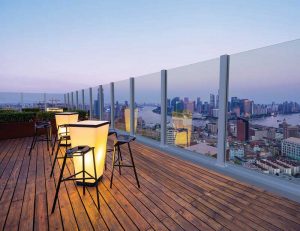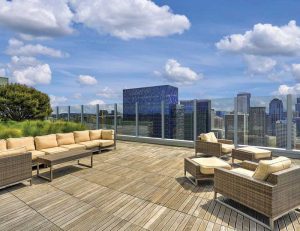Weatherproofing

Weather and waterproofing are important considerations during the specification process. Serious issues can develop when different metals are in contact with one another and nature. Thus, it is important to separate incompatible materials to prevent galvanic corrosion. Movement occurring with changes in temperature must also be considered during the design process. Glass windscreens should be designed to allow for movements resulting from expected temperature changes in the geography of the project. Taking thermal stress into consideration will maintain the structural continuity along the entire windscreen system. Thermal breaks and tolerance gaps within fittings are reviewed per project based on specifications and local code. In areas of high annual rainfall, waterproofing is necessary to safeguard the building’s structural integrity. For regions impacted by hurricanes, or areas prone to high winds, modifications may be required to meet local codes.
Installation
When it comes to installation, traditional glass windscreens involve vertical posts with integrated vertical channels, and often require installers to lift large panes of glass and slide them in from above the post system. Size limitations on the glass of a windscreen become dependent on engineering and the glass fabricator’s capabilities, in general, it would be rare to see a panel larger than 2 m (8 ft) in height or width.

However, as windscreen systems continue to advance, so do installation methods. Some manufacturers offer snap-fit aluminum posts making for quick, safe, and easy assembly. Snap fittings are designed to meet the maximum wind pressures, wind speeds, and wind-borne debris requirements. With one side of the post in place, the glass is positioned in front of the system and held in by double-sided foam tape. The tape holds in the first pane of glass while the next piece is installed. The cover is then snapped in from the front, safely securing the glass panel in place. This simple design reduces the installation time, thereby, lowering labor costs and helping keep a project within budget.
Liability
It is crucial to work closely with the windscreen manufacturer at the onset of the design process. In the author’s experience, it is always beneficial when architects and glaziers enlist the help and expertise of the manufacturer to best understand their options and capabilities. Design is typically delegated with sealed drawings and calculations, especially when determining capacity, structural requirements, and code compliance. Misunderstanding of regulations and a lack of building code knowledge can result in costly rework.
A knowledgeable partner will be able to provide valuable insight regarding regulations and how they might impact the project scope, logistics, and cost.
Conclusion
As interest in functional, comfortable, and visually appealing outdoor spaces continues to rise, so too will demand for commercial glass windscreen systems. Keeping building codes, proper installation, and material selection in mind is critical for designing efficient windscreens that will withstand the test of time and the environment. Fortunately, today’s systems offer an abundance of options that are not only code compliant, but also aesthetically designed to complement and elevate the look and experience of any outdoor space.




